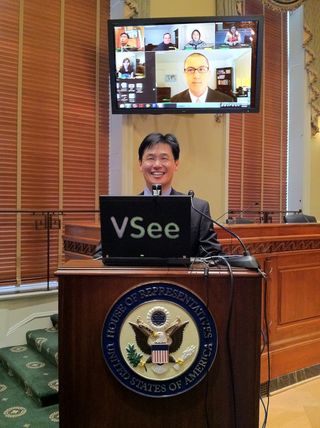Secure and Simple Video Conferencing

This Behind the Scenes article was provided to LiveScience in partnership with the National Science Foundation.
Traditional videoconferencing systems are costly in terms of equipment and notoriously complicated to set up and use. It also turns out that they have many security flaws. Some of these flaws can be fixed with new video chatting technology from VSee.
Rapid7, a company that looks for holes and leaks in computer systems, found that a large number of companies simply put their videoconferencing systems outside of their firewalls to avoid the complex configurations needed to make them more secure. Using a custom program, a Rapid7 security expert found that, in less than three hours, he could virtually "walk right into" more than 5,000 unsecured board rooms via videoconference.
Security holes like those found by Rapid7, as well as the inconveniences posed by traditional videoconferencing systems led Milton Chen and several former Stanford University colleagues to create and develop a new video collaboration tool. With funding from the National Science Foundation’s Small Business Innovation Research grant, VSee was born.
New age conferencing
Unlike traditional videoconferencing systems, VSee uses end-to-end encryption without a man-in-the-middle listener. In many videoconferencing architectures, media is sent to a server (also called a video relay or microcontroller unit). Although encryption is applied from your computer to those servers, the servers have full access to your video stream.
In contrast, VSee uses end-to-end encryption where no server, even VSee's own, has the decryption key.
Sign up for the Live Science daily newsletter now
Get the world’s most fascinating discoveries delivered straight to your inbox.
In addition, VSee does not require administrator permissions or installation. Video conferencing software clients tend to be large, and can leave a big footprint on your system. Almost all of them require administrator permissions to install. Once the client software gains administrator permissions, it can severely compromise your computer security: Asking for administrator permissions is like asking you to throw away your operating systems' natural defenses.
Easy on-the-go

VSee also contains a number of elements that help overcome some of the hurdles faced by people who videoconference. For example, Chen and his colleagues designed the software to make on-the-go collaboration easy by combining instant group video chat with one-click application sharing, and drag n’ drop file transfer.
Such security and simplicity factors were key for a recent decision by the U.S. House of Representatives to adopt the technology for use behind their firewall. Currently, only a few dozen Congressional district offices have video conferencing hardware, due to system costs, complexity, and security holes. With the VSee platform, it is now possible to outfit all the remote district offices essentially for free, potentially saving millions of dollars.
While a graduate student at Stanford University, in Palo Alto, California Chen also worked one day a week at Intel Research Laboratory, in Santa Clara, and was frustrated by his slow commute on the notoriously congested U.S Route 101.
"VSee was created to be the cure for the common commute, so remote work could be productive and social," Chen said. "In fact, VSee’s design is shaped by our own remote work experience. Half of the VSee team is in the Bay Area and only come to the office on Fridays. The other half is spread across Seattle, Los Angeles, San Diego, Dallas, Atlanta, Florida, Virginia, Spain, and Singapore. VSee allows us to get actual work done together from home."
For more on VSee’s work, see the National Science Foundation press releases Conflict Zones, Live and Keeping an Eye on the Inauguration.
Editor's Note: The researchers depicted in Behind the Scenes articles have been supported by the National Science Foundation, the federal agency charged with funding basic research and education across all fields of science and engineering. Any opinions, findings, and conclusions or recommendations expressed in this material are those of the author and do not necessarily reflect the views of the National Science Foundation. See the Behind the Scenes Archive.

